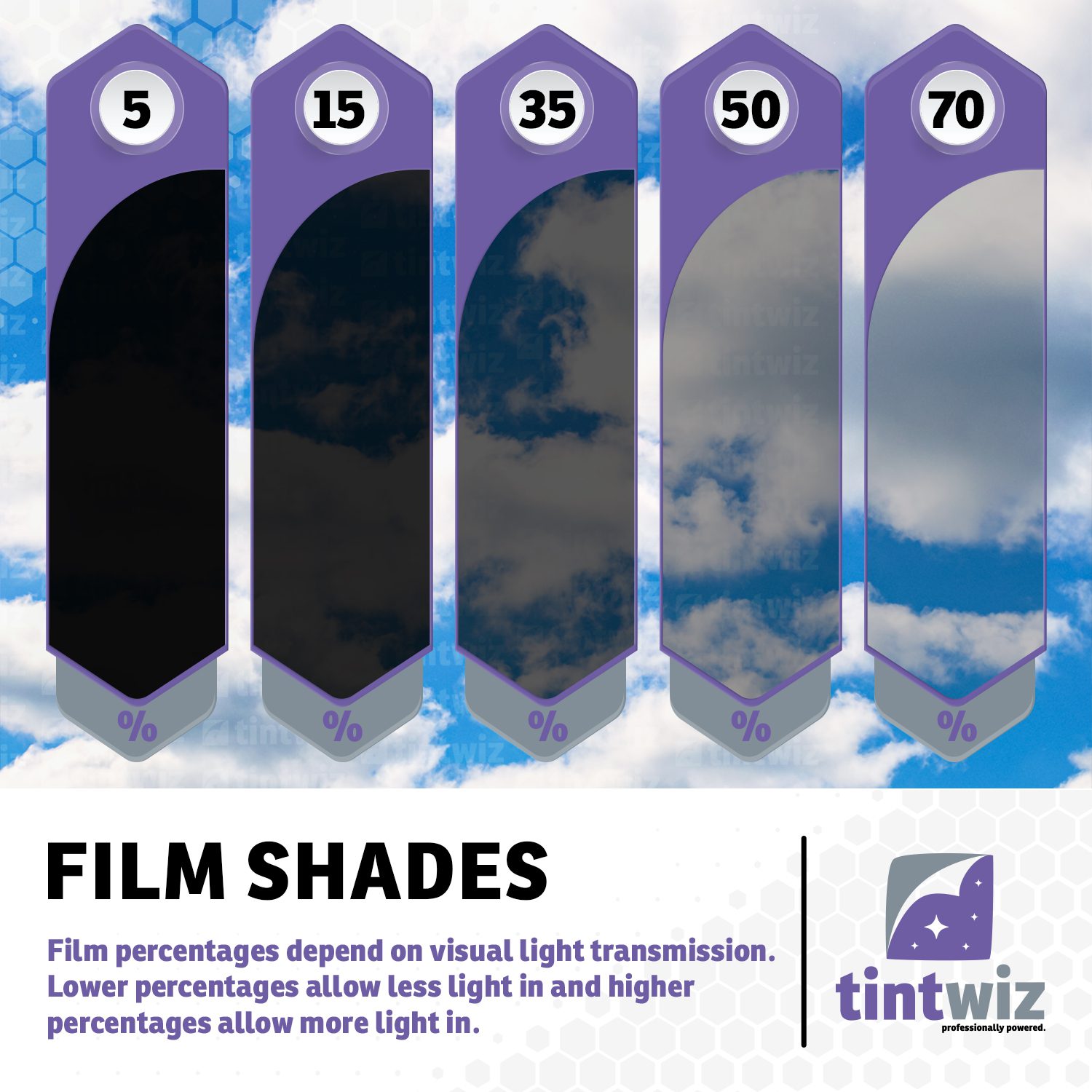Darkest legal tint for Sedans in Georgia
- Windshield: Non-reflective tint is allowed on the top 6 inches of the windshield.
- Front Side windows: Must allow more than 32% of light in.
- Back Side windows: Must allow more than 32% of light in.
- Rear window: Must allow more than 32% of light in.
Darkest legal tint for SUV and Vans in Georgia
- Windshield: Non-reflective tint is allowed on the top 6 inches of the windshield.
- Front Side windows: Must allow more than 32% of light in.
- Back Side windows: Any darkness window tint can be used
- Rear window: Any darkness window tint can be used
Please note: The accuracy, completeness, adequacy or currency of the content is not warranted or guaranteed. We are not lawyers or a law firm and we do not provide legal advice. We recommend you consult a lawyer or other appropriate professional if you want legal advice.

Adding window film to the windows and windshield of a vehicle is arguably the best aftermarket enhancement you can make to your car. Window tinting a vehicle blocks harmful UV light and protects the surfaces in the cabin over the years, and on a more immediate basis, it reduces heat inside the car, making your vehicle more comfortable and meaning less fuel consumed by the AC.
Window tint also adds privacy and style to your vehicle, and it can cut the glare from the sunshine and make driving safer. All in all, it’s a good idea to use window tint, but you need to make sure you follow Georgia’s window tint laws or this welcome upgrade to your car may lead to an unwelcome citation.
Georgia window tint laws were originally enacted in 2005 and have been updated several times since. The state’s window tint laws are clear cut and are relatively permissive, but citation costs can add up, so it’s a good idea not to push your luck. The first thing to understand is that Georgia window tint law allows for a tolerance of 3% light transmission variance, so you have a bit of flexibility with the technical darkness of your tint. To know how close your car, truck, or SUV’s tint is to being outside the law, you need to understand how tint darkness is calculated.
The proper term for window film darkness is “Visible Light Transmission,” which is shortened to VLT. The higher the VLT rating, the clearer the window, the lower the rating, the darker the tint. (Limousines often have a 5% VLT which is called limo tint, e.g.). If your intention is to change the look of your vehicle and/or add privacy, you will want to go with a tint with a lower VLT rating; if you are more interested in UV and IR (infrared) light blocking, then even tints with very high VLT percentages (clearer, e.g.) can be very effective. In other words, darker tint adds privacy and style, but is not needed for cooling or sun protection.
Now let’s look at Georgia vehicle window film laws in 2021 in detail.
Windshield Window Tint Laws in Georgia
Georgia window tint laws allow for a strip of tinting along the top portion of the windshield that can reach down to six inches below the top of the windshield. This is an inch thicker than allowed in most states, so you should have no issue with cars brought in from other states. Windshield tint regulations in Georgia are the same for cars, trucks, SUVs, and vans.
Georgia laws only allow the application of nonreflective tinting on front windshields, a rule similar to laws found in most states; reflective window tint can bounce sunshine into the eyes of drivers in oncoming traffic. Note that worrying about windshield tint in Georgia is often a moot point, as most vehicles have a strip of non-reflective tint that is within the six-inch limit applied before leaving the factory.
Front Side Window Tint Rules in Georgia
In Georgia, cars, meaning sedans and coupes, may have a window tint rated at 32% VLT or lighter on their front side windows, meaning the windows beside the driver and front passenger seats. Larger vehicles, like SUVs, may also have front side window tint as dark as 32% VLT, and remember that allotted variance.
Front side window film in Georgia may have a reflectivity rated up to 20%, and again this regulation applies both to cars and to larger vehicles like vans and trucks. When it comes to rear side windows, Georgia tint laws differ between vehicle types, however.
Rear Side Window Tint Rules in Georgia
The regulations governing rear side windows for vehicles in Georgia differ dramatically for cars and for larger vehicles, but the distinction is clear cut and easy to understand: cars are limited to tint darkened only to the same 32% VLT as with front side windows, while trucks, SUVs, and vans may use any level of tinting for rear side windows.
That means your larger vehicle can have windows as dark or even darker than full privacy 5% limo tint on any side windows behind the driver and front passenger seats, whether the vehicle has two rows of seating or multiple rows.
For both cars and larger automobiles, the side tint on the rear windows is limited to 20% reflectivity, as with the front side windows.
Rear Windshield Tint in Georgia
Cars in Georgia can only have window tint with a 32% VLT darkness on the rear windshield, but the same rules do not apply to larger vehicles.
As with the rear side windows of larger vehicles like vans and trucks, the rear windshield of such registered in Georgia may be tinted to any level VLT darkness. And unlike you’ll find in most states, Georgia window film regulations do not make any stipulations regarding side mirrors as related to rear window tint.
Rear window film may not be reflective or metallic in the state of Georgia.
Window Tint Restrictions and Requirements in Georgia
All shades and colors of window tint are legal in Georgia except for red or amber tints, which are illegal under 2021 Georgia tint laws. If you have had aftermarket window tint applied to your vehicle, state law mandates that you have a sticker certifying the window film as in legal compliance with Georgia law applied in a visible spot on the windshield.
You are also required to use a window film certified to meet state regulations, but if you have window tint applied in Georgia by a reputable tinting company, that should be no problem, as window tint producers and vendors doing business in the state must officially certify the window film they offer as meeting Georgia laws.
Window Tint Medical Exemptions in Georgia
In Georgia, drivers with medical conditions warranting extra protection against sunlight can get a medical exemption allowing darker window film than standard law permits. UV blocking window film can protect both skin and eyes against sun damage, so it is a must have upgrade if you have skin or eye health issues and spend any meaningful amount of time in your vehicle.
Speak to a physician, dermatologist, or ophthalmologist and request a document granting you a medical window tint exemption, then take this paperwork to a tint installer and you can get darker tint as needed.
Just be sure to keep your window tint exemption paperwork in your vehicle at all times.
Window Tint Violation Penalties in Georgia
In Georgia window tint tickets can be assessed at the scene of a traffic stop as police can employ a device that tests visible light transmission. Window tint violations usually cost $124, and you can receive repeated tickets if you don’t have your illegal window tint promptly replaced or simply removed.
Window tint violations in Georgia are misdemeanors and not considered moving violations, but repeated infractions can lead to ever higher financial penalties.
Darkest legal tint for Sedans in Georgia
- Windshield: Non-reflective tint is allowed on the top 6 inches of the windshield.
- Front Side windows: Must allow more than 32% of light in.
- Back Side windows: Must allow more than 32% of light in.
- Rear window: Must allow more than 32% of light in.
Darkest legal tint for SUV and Vans in Georgia
- Windshield: Non-reflective tint is allowed on the top 6 inches of the windshield.
- Front Side windows: Must allow more than 32% of light in.
- Back Side windows: Any darkness window tint can be used
- Rear window: Any darkness window tint can be used









